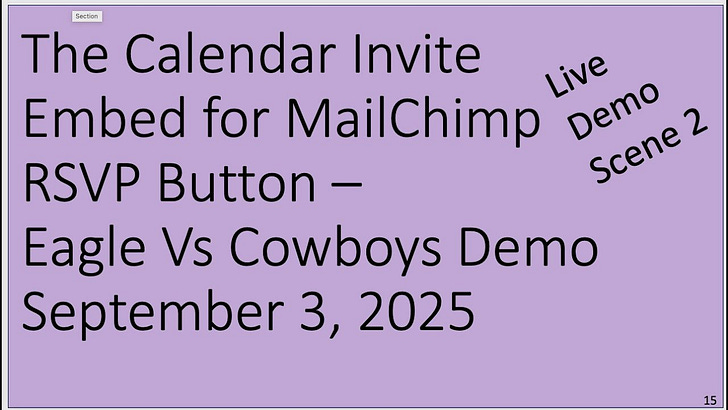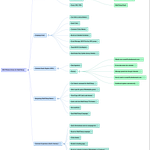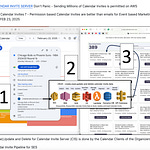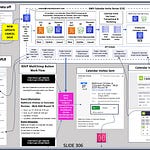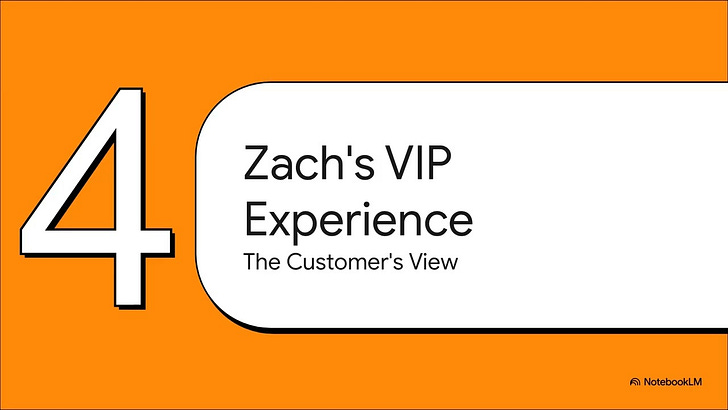The provided sources explain a system designed to integrate Mailchimp campaigns with calendar invitations and RSVP tracking. At its core, the system allows event organizers, exemplified by Mandy, to create event details in Google Calendar, process them through the Calendar Snack app, and then embed a unique RSVP button into their Mailchimp emails.
When recipients, like Zach, click this button, they automatically receive a calendar invite that dynamically updates with any subsequent event changes.
This entire process is supported by the AWS Calendar Invites Server and the Calendar Snack Engine, which work in tandem to build, send, and track all calendar interactions, providing the organizer with valuable RSVP analytics.
The system's key benefit is ensuring accurate, up-to-date event informationis directly placed on attendees' calendars, minimizing confusion from changes.
calendar invite, and their responses are tracked in real-time, providing valuable RSVP analytics back to the organizer. This system efficiently handles multiple updates to event details, automatically pushing changes to attendees' calendars to ensure they always have the most current information, which is a key benefit over simple email updates.
Key MailChimp Calendar Button Topics
Mailchimp RSVP: Seamless Calendar Integration and Event Analytics
What is the primary purpose of the Mailchimp RSVP button feature described in the source?
The primary purpose of the Mailchimp RSVP button feature is to enable event organizers, like Mandy in the demo, to seamlessly integrate calendar invitations into their Mailchimp campaigns. When a recipient clicks the RSVP button within a Mailchimp email, they automatically receive a calendar invite for the event, and their interaction (e.g., saying "yes" to the invite) is tracked, providing valuable RSVP analytics. This allows for direct communication of event details and tracking of attendee engagement.
How does an event organizer, such as Mandy, utilize this system for her Mailchimp campaigns?
Mandy, as the event organizer, uses a combination of tools: her Google Calendar client, the Calendar Snack console, and Mailchimp. She first prepares her event data in Google Calendar, including details like the event name, time, and promotional offers. This data is then sent to create@calendersnack.com for processing. After refining the event details within the Calendar Snack app, she accesses the organizer dashboard, clicks on the Mailchimp RSVP button feature, and obtains a unique API link. This API link is then embedded into her Mailchimp campaign, allowing recipients to click and receive the calendar invite.
What happens when a recipient, like Zach, clicks the Mailchimp RSVP button?
When a recipient like Zach clicks the Mailchimp RSVP button in the email campaign, an API command is triggered. This command requests the calendar invite from a database. The system then dynamically builds a personalized calendar invite for Zach and sends it directly to him. Crucially, Zach's response to the calendar invite (e.g., accepting it) is then tracked and sent back to Mandy's Calendar Snack engine, allowing for real-time RSVP analytics.
How does the system handle updates to event details after the initial invitation has been sent?
The system is designed to handle updates to event details efficiently. If an organizer like Mandy needs to change information such as location, time, date, or promotional details, she simply updates the event within her Google Calendar and resends it through the Calendar Snack processing workflow. The system then identifies which recipients have already received and responded to previous invites (e.g., Zach who said "yes"). These recipients automatically receive an updated calendar invite reflecting the changes, ensuring they always have the most current information.
What is the role of the "Calendar Snack Engine" and "AWS Calendar Invites Server" in this process?
The "Calendar Snack Engine" acts as a central hub and processing unit for the event organizer. It receives event data from the Google Calendar client, generates the unique API links for Mailchimp, and aggregates RSVP analytics. The "AWS Calendar Invites Server" serves as the backend infrastructure for building and delivering the calendar invites on the fly. When a Mailchimp button is clicked, the Calendar Snack Engine communicates with the AWS server to generate and send the invite, and the AWS server also handles tracking calendar receipt confirmations back to the Calendar Snack Engine.
What kind of tracking and analytics are provided to the event organizer?
The system provides detailed tracking and analytics related to RSVPs. When a recipient accepts a calendar invite, this "calendar receipt" is captured and sent back to Mandy's Calendar Snack engine. The engine then aggregates these receipts for "RSVP analytics," giving the organizer insights into who has responded and how they've interacted with the event invitation. This also includes tracking responses to multiple updates of the same event.
Can the system handle multiple updates to the event, and how does it ensure recipients receive the latest information?
Yes, the system is designed to handle "N plus calendar updates," meaning it can accommodate numerous changes to an event. If an organizer makes an update (e.g., changing a booth number or event date), the system pushes this updated information to all relevant recipients who have previously interacted with the invite. This ensures that even if Zach has responded "yes" to an earlier version, he will consistently receive updated calendar invites with the latest changes, maintaining accurate information on his calendar.
What is the benefit of communicating time-based changes through updated calendar invitations rather than just emails?
The primary benefit of communicating time-based changes through updated calendar invitations, rather than just emails, is to ensure the most accurate and up-to-date information is directly on the recipient's calendar. While an email might be overlooked or outdated, an updated calendar invite automatically modifies the event on the recipient's personal calendar. This reduces confusion, minimizes the chance of recipients missing critical changes, and improves the overall attendee experience by centralizing event information where it's most needed.




